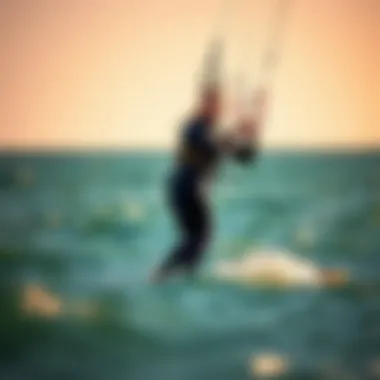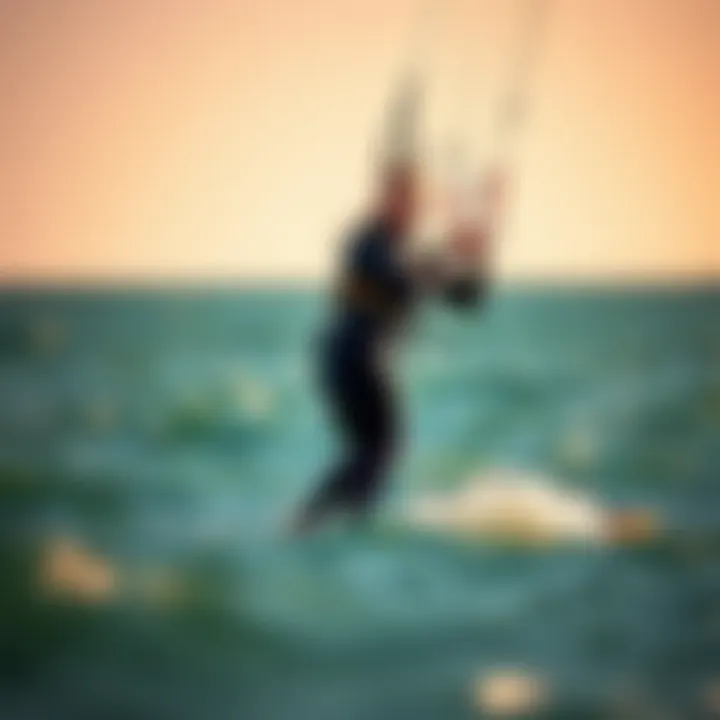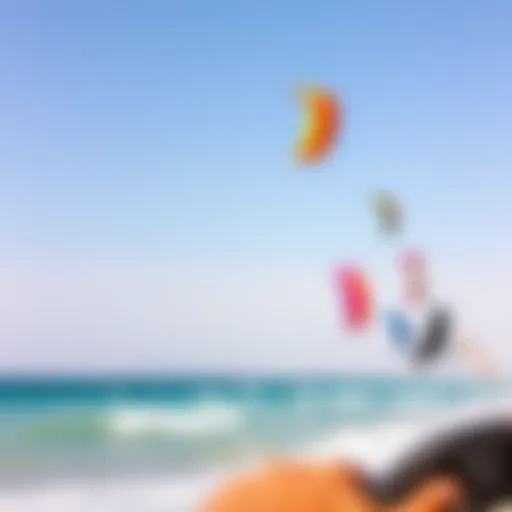Wetsuit vs. Drysuit: Key Differences for Kiteboarding


Intro
Kiteboarding is not just a sport; it's a blend of thrill, technique, and heir to nature's currents. One of the essential decisions a kiteboarder faces is choosing the right suit for their aquatic escapades. The debate between wetsuits and drysuits has long puzzled even seasoned enthusiasts. Each has its merits, and selecting one depends largely on the conditions, personal comfort, and those wild adventures waiting on the horizon.
Understanding the subtleties between these two types of suits goes beyond simply looking for comfort or protection. It’s about optimizing your experience on the water while ensuring safety and performance. Each suit provides unique benefits tailored for specific environments, and this guide aims to illuminate those distinctions. We’re diving into the nitty-gritty of wetsuits and drysuits, dissecting materials, design features, and how these factors influence kiteboarding enthusiasm in various situations.
As we sail through this analysis, we’ll also explore gear selection, honing skills, and practical care tips for preserving these essential pieces of equipment. Whether you're just dipping your toes in or you’re a seasoned kiteboarder ready to take on the waves, this exploration will arm you with the knowledge to make well-informed decisions on your kiteboarding gear.
Prelude to Thermal Protection
When it comes to kiteboarding, thermal protection is not just an optional accessory; it’s a necessity for those who want to enjoy the sport in comfort and safety. The chill of open water can bite, often leading to discomfort and even hypothermia if one is not adequately outfitted for the conditions. The choice between a wetsuit and a drysuit plays a pivotal role not only in performance but also in your overall experience on the water.
Understanding thermal protection allows kiteboarders to make smarter equipment choices based on their unique needs. This protective gear ensures that you can maintain thermal regulation while flying across the waves, allowing for sustained performance throughout various weather conditions. The right suit can keep body temperature just right—it’s not always about warmth but about managing your comfort level effectively while riding those wind-powered waves.
Importance of Thermal Regulation
Thermal regulation in sports like kiteboarding is crucial. The body reacts to changing conditions, and hypothermia can set in before you know it, especially during cooler months.
- Body Temperature Management: A wetsuit is designed to trap a thin layer of water next to the skin, which quickly warms up with body heat. In contrast, a drysuit offers an airtight seal that prevents water from entering, keeping you completely dry and insulated.
- Enhanced Endurance: If you're frequently battling against the wind and waves, maintaining an optimal body temperature allows you to ride longer and with less fatigue.
- Safety: Protecting your body from the cold means you're also reducing the risk of cramps, fatigue, and other physical mishaps. Safety is paramount when you’re out in the big blue; a misstep can spell disaster.
"Staying warm is not just about comfort; it’s about staying safe and performing at your best."
Factors Influencing Suit Choice
Choosing between a wetsuit and a drysuit isn’t simply a matter of brand or style; several factors can impact this decision:
- Water Temperature: Your location plays a significant role. If you’re catching air on the chilly shores of the Pacific Northwest, a drysuit might be your best bet. On the flip side, if you find yourself in the warm Caribbean waters, a wetsuit could suffice.
- Duration of Exposure: Planning to paddle around for hours? A drysuit can keep you dry and comfortable for extended periods, while a wetsuit might leave you feeling a bit nippy if the water is too cold.
- Comfort and Fit: Some kiteboarders prioritize freedom of movement. The snug fit of a well-designed wetsuit might offer greater flexibility compared to a bulkier drysuit, which often has a looser fit.
- Environmental Factors: Wind chill and water conditions also come into play. If the wind is howling and the water cold, a drysuit may be more appropriate to fend off the biting air while you kite.
Knowing these factors equips you to make an informed choice that not only enhances your kiteboarding experience but also keeps you safe and comfortable in various environments.
Understanding Wetsuits
Understanding wetsuits is crucial for kiteboarding enthusiasts who want to make the most of their time on the water while remaining comfortable and safe. A wetsuit acts as more than just a layer of insulation; it’s a necessary tool that enhances performance in varying water temperatures and conditions. Whether you’re carving through warm waves or tackling colder waters, grasping the intricacies of wetsuits can help you choose the right gear to elevate your kiteboarding experience.
Material Composition
Neoprene
Neoprene is the magic fabric behind most wetsuits. Its synthetic rubber properties allow for flexibility and insulation, which are key for kiteboarders who navigate dynamic and sometimes cold water conditions. One of its standout features is its ability to trap a thin layer of water between the suit and the skin. This water warms up with body heat, creating an insulating barrier that keeps you snug and cozy.
A major draw of neoprene is its durability. It holds up well under various conditions, even with frequent exposure to saltwater and sun. However, the downside is that it can be tough on the environment, as traditional neoprene is derived from petroleum.
Thermal Liners
Thermal liners, often found in higher-end wetsuits, provide an additional layer of warmth. These materials are engineered to enhance thermal retention by reflecting body heat back while allowing moisture to escape. The unique feature here is their soft texture, which not only provides warmth but also comfort against the skin.
Using thermal liners means you can spend more time on the water without feeling like you’re slowly turning into an icicle. On the flip side, this does come at a price—thermal liners can hike up the cost of the wetsuit, making them less budget-friendly.
Design Characteristics
Fit and Flexibility
The fit of a wetsuit can greatly influence your kiteboarding performance. A well-fitted wetsuit hugs closely to your body, preventing water from rushing in while still allowing for movements that feel natural. Flexibility is also paramount, as kiteboarding requires a range of motion from your arms and legs.
For many athletes, the tighter the fit, the better, as long as it doesn't inhibit movement. There’s a balance to strike here since overly tight suits can cause discomfort, while loose ones lose effectiveness. Ultimately, a good wetsuit should feel like a second skin, enabling you to fully focus on that exhilarating ride.
Seam Construction
Seam construction techniques in wetsuits affect their water resistance and durability significantly. Flatlock seams, for instance, are highly breathable and comfortable but can let small amounts of water in. On the other hand, blind-stitched seams are watertight and designed for cold conditions, though they can be less flexible.
Choosing the right seam type involves considering your primary use. If you're often in colder water, opt for blind-stitched seams. However, if you're mostly in warmer climates, flatlock seams might serve your needs just fine. Each type of seam comes with its advantages and potential drawbacks, depending on the context of your kiteboarding adventures.
Performance in Water
Insulation
Insulation is the core purpose of a wetsuit. It is crucial in maintaining body temperature during long outings, especially in cooler waters. Wetsuits with a thickness range of 3-5 mm provide excellent insulation. The thicker the material, usually means better thermal protection but can interfere with maneuverability. For kiteboarders, finding that sweet spot in insulation is key for comfort and performance.


Moreover, not all insulation is created equal; the quality of the neoprene and design significantly impacts its effectiveness. By choosing a well-fitted wetsuit with the right insulation, you can enjoy sessions that push your limits without risking hypothermia.
Mobility
Mobility while kiteboarding is vital. Water sports demand a degree of agility and responsiveness that can be hampered by improper gear. A wetsuit that limits your movement can lead to sluggish performance or loss of balance. Thus, flexibility is a top factor to consider when selecting a wetsuit. Many brands today emphasize providing greater flexibility through advanced cuts and materials. The goal is to keep you agile enough for those tight turns and jumps that every seasoned kiteboarder dreams of.
Suit Types and Thickness
Shorty vs. Full
When it comes to choosing between a shorty and a full wetsuit, it really boils down to your local water temperature and personal comfort. Shorty wetsuits cover the torso but leave the arms and legs exposed, making them ideal for warmer climates where the water feels more inviting. They provide enough warmth while allowing the freedom of movement, which is a necessity when you're flying in the air.
In contrast, full wetsuits provide comprehensive coverage and are better suited for colder water conditions. They are typically thicker and offer superior insulation, helping to keep your body heat intact during chilly sessions. Depending on where you kiteboard, having both options in your arsenal can give you better control over your comfort level in variable conditions.
Cold Water vs. Warm Water
The primary distinction between cold water and warm water suits lies in the overall thickness of the material used. Cold water suits often range from 4-6 mm in thickness, providing substantial insulation against frigid waters, whereas warm water suits are generally 2-3 mm thick, designed to keep you comfortable without overheating.
Your comfort level and performance can hinge on making the right choice here. Kiteboarding in cold conditions without adequate protection can lead to rapid heat loss, meaning less fun and more focus on getting out of the water.
Understanding the differences in wetsuit construction lets athletes prepare better for their environment. Being aware of the temperature and potential range of conditions you might encounter during kiteboarding helps ensure you’re equipped for every adventure.
Exploring Drysuits
Diving headfirst into the world of drysuits for kiteboarding enthusiasts provides pivotal insights into ensuring comfort and safety. Drysuits serve a specialized purpose, distinct from wetsuits, and navigating through their various features, materials, and benefits is crucial for those seeking the ultimate experience on the water. By understanding the multifaceted nature of drysuits, kiteboarders can make choices that not only enhance their performance but also cater to their individual thermal and mobility needs.
Material Composition
Waterproof Fabrics
When it comes to drysuits, the composition of materials is key. Waterproof fabrics are the backbone of any drysuit, ensuring that water remains on the outside while keeping the inside snug and dry. These materials like Gore-Tex or similarly engineered fabrics are known for their robustness and water-resistance. A major characteristic of these fabrics is their ability to withstand various weather elements while allowing moisture vapor to escape.
This breathability is particularly beneficial, as it helps in regulating temperature during exertion, making sure the suit isn't just a barrier against water but a complex system that manages your microclimate effectively. However, a trade-off exists. While these fabrics are designed to keep you dry, they may not provide the same warmth as a thicker wetsuit in frigid waters.
Breathability Features
Breathability features in drysuits contribute significantly to comfort and performance levels. This characteristic ensures that as you engage in kiteboarding—an activity that can raise heart rates significantly—the sweat will not be trapped inside the suit. The inclusion of ventilation systems or strategically placed mesh panels in drysuit design allows for heat regulation while actively participating in the sport.
This feature is applauded for reducing overheating, as enthusiasts may find discomfort in overly insulated systems. A potential downside could be the potential for water entry during prolonged immersion, requiring careful consideration of how, when, and where to use these suits.
Design Characteristics
Seals and Zippers
Integral to the effectiveness of drysuits are the seals and zippers. The seals often made of latex or neoprene, play a critical role in preventing water ingress. This characteristic is paramount to ensure that the suit functions as intended—keeping the wearer completely dry. Drysuit designs with high-quality zippers, especially those that are waterproof, enhance the overall integrity of the suit by minimizing openings where water could enter.
The perception of wearers is that good zippers can either make or break the experience inside the suit. Fumbling with zippers is less than ideal when you’re in icy waters, where every second counts. The downside? Tending to seals can become an art form; they need careful maintenance to avoid tears and leaks, which can significantly affect performance.
Layering Systems
Layering systems in drysuits add another dimension to the functionality. Drysuits allow for the incorporation of thermal layers underneath, enabling riders to customize thermal protection according to the temperature and wind conditions. This adaptability is why many kiteboarders favor drysuits; they offer exceptional versatility.
Choosing the right base layer under the drysuit can mean the difference between shivering and conquering the waves comfortably. However, there’s a catch—choosing too many layers can affect mobility and put pressure on the seals, risking water entry.
Performance in Water
Temperature Control
Drysuits excel at temperature control, which distinguishes them within the family of thermal suits. Unlike wetsuits, which rely on a thin layer of water that warms up close to the skin, drysuits create a sealed environment that keeps water out entirely. This is crucial for kiteboarders who frequently encounter variable temperature conditions in open water environments.
However, managing that environment can be tricky; too much heat retention can lead to sweating, particularly during high-energy activities, which is where breathability factors come into play. A balance must be struck to ensure neither too much heat nor too much cold is felt.
Buoyancy Considerations
Another critical aspect is understanding buoyancy in drysuits. They are designed to provide a level of buoyancy, which can be advantageous when paddling or in emergency situations. This quality can assist kiteboarders in remaining afloat while facing tough conditions. However, the added buoyancy may alter the rider’s stance in the water, which can affect coordination during maneuvering.
Balancing this buoyancy against personal comfort is essential as it may feel like a potential hindrance rather than a help, particularly for the uninitiated or those who favor lower-profile designs.
Suit Types and Features


Front Zipper vs. Back Zipper
The debate between front zippers and back zippers is notable within the drysuit community. Front zippers facilitate easier entry and exit, a quality appreciated by many kiteboarders after a long session on the water. However, they can sometimes compromise seal effectiveness, depending on the design.
Back zippers, on the other hand, are often considered more robust in maintaining water resistance. They require a bit of dexterity to fasten and unfasten but offer a feeling of secure insulation.
Integrated Accessories
Integrated accessories—such as built-in booties, hoods, or gloves—are features that add to the drysuit’s overall appeal. They effectively minimize the points where water can enter and add an extra layer of comfort. However, integrated components can limit flexibility, which may not suit every kiteboarder's preference; thus it’s vital to assess personal styles and needs carefully.
Ultimately, the exploration of drysuits sheds light on a myriad of elements that reflect on performance, comfort, and safety for kiteboarding enthusiasts. Understanding these specifics can help individuals choose the right gear tailored to their ambitions and preferences in diverse water conditions.
Wetsuit vs. Drysuit: Key Comparisons
When it comes to choosing between a wetsuit and a drysuit for kiteboarding, it's essential to dig into the nitty-gritty details. Picking the right suit isn't just about what's stylish or convenient; it's about how it affects your performance on the water, and, more importantly, your comfort and safety. In this section, key points regarding thermal efficiency, comfort, suitability for various conditions, and cost considerations will be discussed. Understanding these differences will allow kiteboarders at any skill level to make more enlightened choices based on their personal needs.
Thermal Efficiency
Thermal efficiency plays a crucial role in ensuring that you stay warm while kiteboarding, especially in colder water. Wetsuits, typically made of neoprene, work by trapping a thin layer of water between the body and the suit. This water then warms up from body heat, providing insulation during your session. However, as the suit ages or if it has thin spots, it might not retain that warmth efficiently anymore.
On the flip side, drysuits excel in thermal efficiency by keeping you completely dry. They feature sealed seams and watertight zippers—creating a barrier against water ingress. Drysuits can accommodate thermal layers underneath, allowing for additional insulating materials like fleece to be added according to the conditions.
Here's a brief comparison of both:
- Wetsuit: Traps water for insulation; relies on body heat.
- Drysuit: Keeps total water out; offers customizable insulation.
"Choosing the right thermal protection can mean the difference between a fun day on the water and an uncomfortable one."
Comfort and Mobility
Comfort is where many kiteboarders find differing opinions. Wetsuits usually offer a good balance of stretch and support, allowing for efficient movement. The flexibility of neoprene lets you perform tricks and maneuvers without feeling restrained.
Drysuits, while providing excellent insulation, can sometimes feel bulky. The added layers needed for warmth may limit your range of motion, especially in the arms and legs, which could affect your performance. Certain designs do help mitigate this, but it’s a factor to consider when weighing your options.
In summary:
- Wetsuit: Generally more flexible and easier to move in.
- Drysuit: May hinder mobility due to bulk but offers superior warmth.
Suitability for Varied Conditions
Different kiteboarding experiences will dictate which suit is more appropriate. For those planning to ride the waves in tropical climates, a light wetsuit or possibly even just board shorts is sufficient. In contrast, when the temperatures drop, say in early spring or late fall, a drysuit can save the day as it keeps the body fully insulated from colder waters.
Here’s how each performs:
- Wetsuit: Best for warm to mildly cool conditions, with a thickness that can be adjusted based on temperature.
- Drysuit: Designed for colder, harsher conditions, capable of maintaining comfort in extreme temperatures.
Cost Considerations
Cost is often a significant deciding factor. Wetsuits usually start off at a lower price point. The quality can vary widely, but you get what you pay for—cheaper suits may not last as long or might not perform effectively in colder waters.
Drysuits typically range higher in price due to their complex material construction and added features. But investing in a good drysuit may save you money in the long run if you frequently kiteboard in colder climates, as you won't need to constantly replace worn-out wetsuits.
When comparing:
- Wetsuits: More affordable up front but may lead to more frequent replacements.
- Drysuits: Higher initial investment but longer lifespan with proper care.
Real-World Applications
Understanding how wetsuits and drysuits function in practice is paramount for kiteboarding enthusiasts. Not all days on the water are created equal, and the applications for each type of suit can vary widely based on environmental conditions, personal comfort, and safety. This section delves into scenarios kiteboarders may encounter and how the choice of thermal protection can significantly enhance their experience.
Kiteboarding in Cold Water
Cold water kiteboarding presents a unique set of challenges that demand adequate thermal protection. In regions where the temperature dips below a certain degree, such as the northern coasts of Europe or parts of North America, the decision often leans towards a dry suit. A dry suit keeps water out entirely, allowing for better insulation, meaning you stay warm even in frigid waters. Alternatively, some kiteboarders opt for wetsuits, especially if they are on a budget or if it's late spring where the water, while still cold, is no more than a brisk experience.
- Advantages of Drysuits in Cold Water:
- Considerations for Wetsuits in Cold Water:
- Complete waterproof barrier
- Better insulation with layering
- Enhanced buoyancy, reducing fatigue


- Affordability and availability
- Easier entry and exit, especially after long sessions
- May require thicker materials for insulation
When opting for a cold water suit, making sure it is well-fitted and sealed can mean all the difference between a great day and a chilly excursion that might cut your fun short.
Kiteboarding in Warm Water
Conversely, warm water kiteboarding caters more towards wetsuits or even shorty suits—those that offer less coverage while still providing some protection against UV rays and irritants in the water. Regions like the Caribbean or the Mediterranean are perfect spots where enthusiasts can don lighter suits without the bulk brought on by insulation layers.
- Benefits of Wetsuits in Warm Water:
- Drysuit Drawbacks in Warm Water:
- Lightweight and more comfortable on hot days
- Easier mobility with flexible material
- Protects from sunburn and jellyfish stings
- Potential overheating during constant activity
- Heavier and more cumbersome
Choosing the right suit for warm waters might seem straightforward, but it requires an understanding of both material and your activity level. A well-chosen wetsuit can allow for maneuverability while providing much-needed protection.
Environmental Factors to Consider
Mother Nature is unpredictable; her conditions dictate a kiteboarder's experience. Wind patterns, water temperature, and the season play large roles in determining the optimal suit for the day. Here are the environmental factors to consider:
- Water Temperature:
The key player in choosing between wetsuit and drysuit. Knowing the exact temperature helps in selecting the right thickness and type of suit to keep you comfortable. - Wind Conditions:
High winds can lead to rough water; if you're planning a session where crashes are likely, more thermal protection is wise. - Sun Exposure:
The sun's strength can greatly affect whether you need the full coverage of a wetsuit or if a shorty will suffice. Always pay attention to UV warnings in your area.
Maintenance and Care
Caring for your thermal protection gear is like tending to a prized instrument; the better you treat it, the longer it serves you well. Regular maintenance not only keeps your wetsuit or drysuit in peak condition but also enhances your overall kiteboarding experience. It’s essential to understand the specific cleaning practices, storage methods, and longevity tips to ensure your suit stands the test of time and use.
Cleaning Techniques
Wetsuit Cleaning
Wetsuits can take a beating, absorbing saltwater, sand, and body fluids over time. The cleaning process starts right after you exit the water. Rinsing your wetsuit with fresh water helps to prevent the buildup of salt and other residues that can break down the neoprene. Make sure you let it soak for about 10 minutes before giving it a gentle scrub with wetsuit-cleaning liquid or even mild shampoo.
A key characteristic of wetsuit cleaning is its role in optimizing the suit's performance. A clean wetsuit contributes to better insulation and flexibility. That’s probably why many serious kiteboarders emphasize this as an important ritual. The unique feature here includes the ability of special wetsuit cleansers to restore the neoprene’s properties without compromising its integrity. However, you need to avoid harsh detergents, as they can be detrimental. A downside, if not cleaned correctly, is the potential for odors and a decrease in performance, making regular upkeep crucial.
Drysuit Maintenance
Drysuits, on the other hand, come with their own set of care requirements given their complexity and the materials involved. Unlike wetsuits that primarily insulate with water, drysuits aim to keep the water out altogether. That’s why maintaining the seals and zippers is paramount. After each use, it’s vital to rinse off the outer fabric and ensure no salt deposits are left behind.
Another significant aspect of drysuit maintenance is the inspection of the lining and the seals. Checking for any small tears or signs of wear can make a world of difference in your suit's lifespan. Many drysuit wearers find that a silicone-based lubricant for zippers not only facilitates smoother operation but also can extend their lifespan. While some might argue about the necessity of this step, the benefits of effortless operation cannot be overstated, especially when time is of the essence on a windy day. However, not all drysuits are equal; some require more attention than others based on fabric and design, making it necessary to read the manufacturer's care instructions.
Storage Recommendations
Proper storage is as critical as cleaning. After washing and drying your wetsuit or drysuit, carefully hang it on a broad hanger to avoid creases. For wetsuits, consider storing them in a cool, dark place, as direct sunlight can degrade neoprene. Drysuits should be stored flat or on a hanger with padding to maintain their shape and integrity. Never shove your suit in a cramped space; it can lead to tiny wrinkles that, over time, might weaken the fabric. Keep them away from sharp objects or environments with a lot of movement to prevent unintentional ripping.
Longevity Tips
To maximize the life of your suits, adhere to a few straightforward rules. First off, always rinse your suit in fresh water after each use, ensuring no contaminants linger. Second, allow your suits to dry fully before rolling or storing them; damp environments can harbor mold. Third, avoid stepping on abrasive surfaces while wearing a wetsuit or drysuit. Those little scrapes can worsen with frequent exposure to rough terrains.
Tending to your suits with diligence and care doesn’t merely extend their life; it also enhances your comfort and performance on the water. Regular maintenance establishes a strong rapport between you and your thermal gear, ensuring that each kiteboarding session is as enjoyable as the last. As the old saying goes, "A stitch in time saves nine," and nowhere is this truer than in caring for your thermal protection gear.
Closure: Making an Informed Choice
Choosing between a wetsuit and a drysuit can feel like picking your favorite child – it’s no easy feat. Each has its unique benefits, which cater to various needs and preferences among kiteboarding enthusiasts. This final section aims to weave together the vital threads of our discussion, equipping you with a clear understanding of how to make the right decision for your next kiteboarding adventure.
Evaluating Personal Needs
Before you take the plunge into the world of thermal suits, it’s essential to evaluate your personal needs. Think about the following factors:
- Water Temperature: Understand what temperature ranges you’ll be dealing with. In chillier waters, a drysuit may offer the insulation and protection needed, while warmer climates might call for the flexibility offered by a wetsuit.
- Duration of Water Exposure: If you’re planning on spending long hours on the water, comfort will be key. A drysuit’s better heat retention might win out against a wetsuit; however, it’s crucial to ensure that fit isn’t compromised.
- Type of Activity: The intensity of your kiteboarding session can influence the choice as well. High-intensity sessions may require a suit that allows for more movement, possibly leaning towards a wetsuit.
- Budget Considerations: Cost is also a major player. Drysuits tend to be pricier than wetsuits, not just in initial investment but also in maintenance expenses.
By clearly identifying your own requirements, you’ll set the stage for making a more informed choice.
Future Trends in Thermal Suits
As technology continues to advance, the world of thermal suits is changing faster than you can say "kiteboarding." Here are some trends to keep an eye on:
- Advanced Materials: Manufacturers are innovating with lighter and more breathable fabrics. New blends, combining neoprene with lighter textiles, improve mobility while retaining thermal efficiency.
- Eco-Friendly Options: With growing environmental awareness, brands are pivoting toward sustainable materials and manufacturing processes. Suits made from recycled materials or bio-based fabrics are becoming more mainstream.
- Custom Fit Technologies: The emergence of 3D body scanning for complete custom suits is not far off. This technology allows for suits tailored to individual body shapes, ensuring comfort and efficiency in the water.
- Smart Functions: Imagine your wetsuit sending you data on your body temperature or water conditions while you kite. Wearable technology is gradually making its way into thermal suits, pushing the boundaries of what’s possible on the water.
Keeping an eye on these trends will help you stay ahead of the game and make choices that align with both your personal preferences and ecological responsibility.
Investing time to assess your own needs and staying updated on future trends will lead you toward a confident decision. In the end, whether you opt for a wetsuit or a drysuit, the most vital part is enjoying the ride, staying safe, and soaking in all the exhilarating moments kiteboarding has to offer.
"The best captain doesn't just navigate the waters. They understand the winds and currents, making decisions that keep them afloat."
Dive into more about maintaining your gear: Reddit Kiteboarding Discussion, or check for updated product discussions on Wikipedia's Kiteboarding Page.
Learn from resources like Kiteboarding.org for community recommendations and advice.















